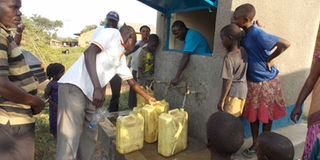Piped water offering fresh start In Masaka

For the first time in history, residents in Kamuzinda Trading Centre can obtain water from a kiosk. PHOTOS BY MICHAEL J. SSALI
What you need to know:
Rural folk used to collect water from the village wells and it was a good way of socialising. Women met there to catch up, but it also came with dangers such as teenagers meeting there for risky behaviour that led to unwanted pregnancies and HIV infections
There is something mystical about traditional wells and springs in many parts of rural Africa. Some of the few remaining wells are as old as the hills. In much of Buganda sub-region, traditional wells have names such as Nalongo (mother of twins), Kamiranngoma (swallower of drums) and other names that tend to link their origin to the spirits.
Most of them were located in the valleys and under forest cover which provided a cool environment and kept their water relatively cold. The village chief periodically sounded a drum to summon every household to send a representative to the clearing of the bush around the well or spring to keep its water free from contamination. If the people did not pay for the water in monetary terms back then, they periodically spent some of their time doing physical work to sustain the wells and springs.
Changing the tide
Over the years, however, the phenomenon of a traditional village well has disappeared in many communities due to rapid population growth, urbanisation, agricultural work, and climate change. The forests are being cleared and the swamps are drained to create space for crop cultivation. Agricultural work often involves irrigation and drawing large amounts of water for livestock to drink (e g cattle zero-grazing and poultry keeping). What used to be natural sources of water have either dried up or been polluted, leading to increased water scarcity.
Many communities nowadays draw water for domestic use from streams where also livestock are taken to drink, which attracts disease. This was the reason that now water had to be pumped from hundreds of meters underground.
The evolution
When Kamuzinda Rural Growth Centre Water Supply Scheme was finally completed and ready for handing over to the community in July, local leaders still had an uphill task educating the scheme’s beneficiaries about their responsibilities to sustain it.
The Rotary Club of Falmouth in the UK, through the Rotary Clubs of Masaka, Kalisizo and Kyotera, had donated more than Shs224m for the construction of a piped water system to benefit the villages of Bulegeya, and Manywa, Kamuzinda Trading Centre, and Kamuzinda Health Centre in Masaka District. Masaka Rotary Club President, Joseph Walusimbi, Ssemugenyi, told community members, “…Besides the piped water, 20 households have received rainwater tanks, and an Ecosan latrine has been constructed for Kamuzinda Primary School, and two boreholes have been acquired for you.”
The old practice of walking to the common water sources in the valley was being discouraged. “I know that the arrival of piped water in our community is bound to change some of our traditional ways,” said Paul Migadde, Sub-county chairman who was the chief guest. “We were all used to the traditional African well which gave the women the freedom to leave home time and again to meet their friends at the well. It has also been an opportunity for village members to meet.
But it has also been misused especially by teenagers who have engaged in behaviours that have resulted in underage pregnancy and increased HIV infection. Yet, as you know, most of our wells have dried up and the safety and cleanliness of the water that we have in our remaining streams cannot be guaranteed.”
Changing of traditions was however not only the challenge that had come with the new water scheme. Everyone had to pay Shs150 for a 20-litre-jerrycan of water obtained from the water kiosks. This was difficult to understand for most people since it had been publicly announced that the water scheme was a donation from Rotary International.
A 20 KV diesel generator had been installed to facilitate the running of the submersible water pump and it requires 35 litres of diesel to fill the reservoir tank after five hours of pumping. There was need for money to sustain the water system in good working condition and to pay for the diesel consumed by the generator.
“The major challenge is that the recipient community has not fully embraced its responsibility regarding the operation and maintenance of the project,” said Engineer Damalie Nabitula of Rodel Civil Engineering Ltd, the company that was contracted to construct the water scheme. She said the cost of a 20-litre-jerrican of water would reduce if the system is connected to the national grid.
“Paying for water is not new in this area anyway,” Namwandu Namusoke of Kamuzinda Trading Centre told Daily Monitor. “We have been buying it in jerricans from water vendors much of the time when we were not even sure where it came from.” She said that often vendors carrying 20-litre-jericans of water on motorcycles charged Shs300 per jerrican.




